Fascinated with Imaging Technologies Since Age 8
Fascinated with Imaging Technologies Since Age 8
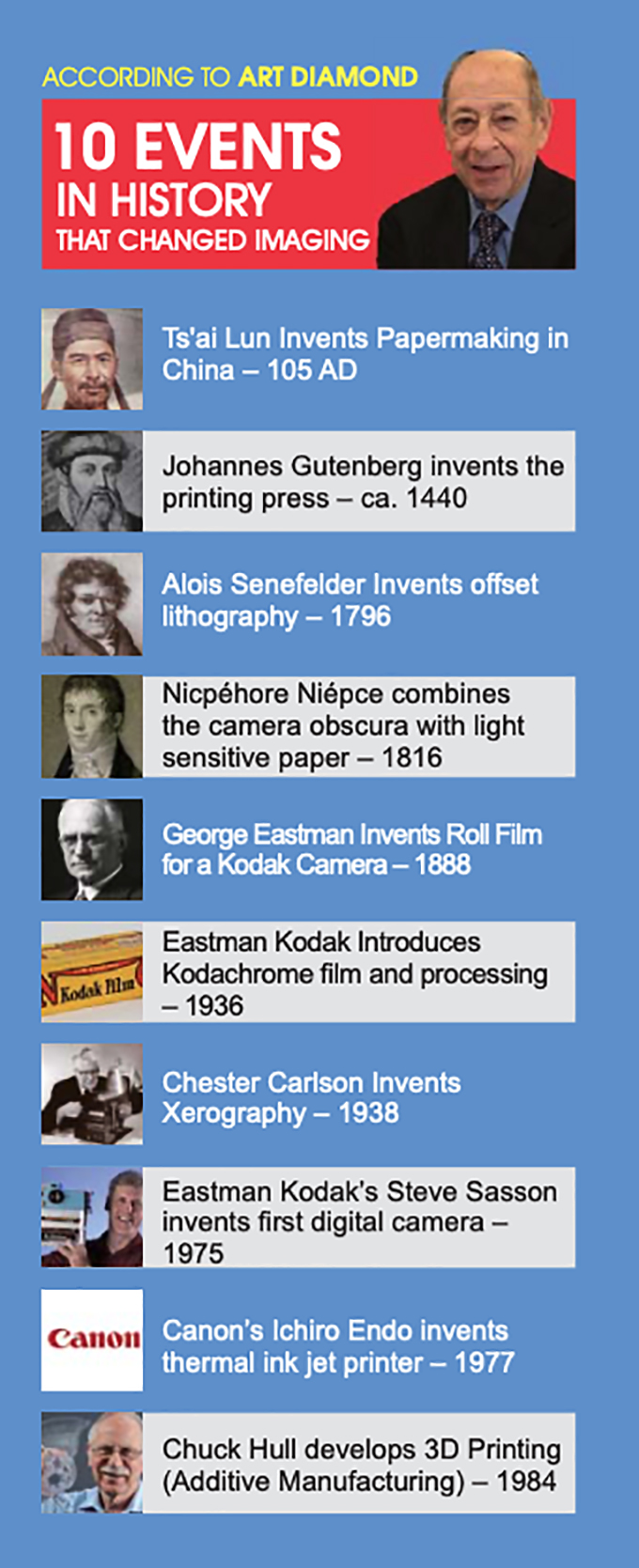 The story is told of a large crowd gathered in St Peter’s Square in the Vatican City pressing against all odds to get a better glimpse of the Pope, who would soon appear on the balcony. Eventually, two figures emerged but it was difficult to see. One disgruntled traveller at the back of the crowd begged another sightseer standing beside him for a quick loan of his binoculars so that he too could see. His request was rejected. “Well tell me,” said the man in frustration. “What can YOU see?”
The story is told of a large crowd gathered in St Peter’s Square in the Vatican City pressing against all odds to get a better glimpse of the Pope, who would soon appear on the balcony. Eventually, two figures emerged but it was difficult to see. One disgruntled traveller at the back of the crowd begged another sightseer standing beside him for a quick loan of his binoculars so that he too could see. His request was rejected. “Well tell me,” said the man in frustration. “What can YOU see?”
“Well, there are two men up there,” he started while straining to see more. “The one on the left is wearing a white cloak, has a white cap on his head and he is praying. I don’t know who he is. But the guy standing next to him… why that’s Art Diamond!”
Yes… everyone, on every continent, knows Art Diamond—a veteran of the imaging industry for almost 60 years.
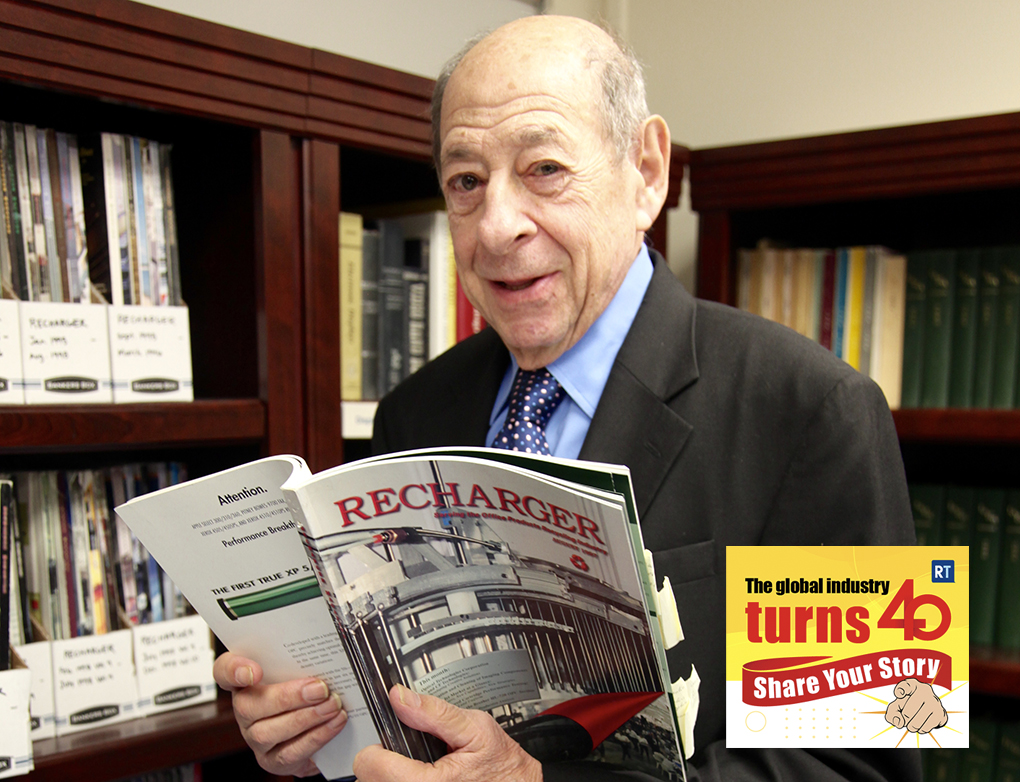
Diamond picks up a copy of Recharger Magazine—a part of his extensive imaging library donated to CalPoly University.
Diamond is known internationally for his chemical engineering consultancies, his fifteen US imaging patents, his authoring of the “Handbook of Imaging Materials,” his 31 years of trade events on three continents, and his various magazine publications including R&R News and Imaging News.
Back in the 1990s, Diamond helped me establish ACRA—the print consumables trade association in Australia and New Zealand—and start a series of annual R&R events there. Then in June 2011, he agreed to be Senior Consulting Editor of this publication —RT ImagingWorld magazine, which was previously called Recycling Times.
He wrote a monthly column, wrote, illustrated and photographed feature articles, edited and proofed each final pre-press issue before publication. Drawing on his experience as an editor and publisher, he established editorial policies and helped attract industry experts as writers.
The magazine rapidly built an impressive base of readers and display advertisers and within four years, became the leading publication, worldwide, for the cartridge recharging industry—in four languages.
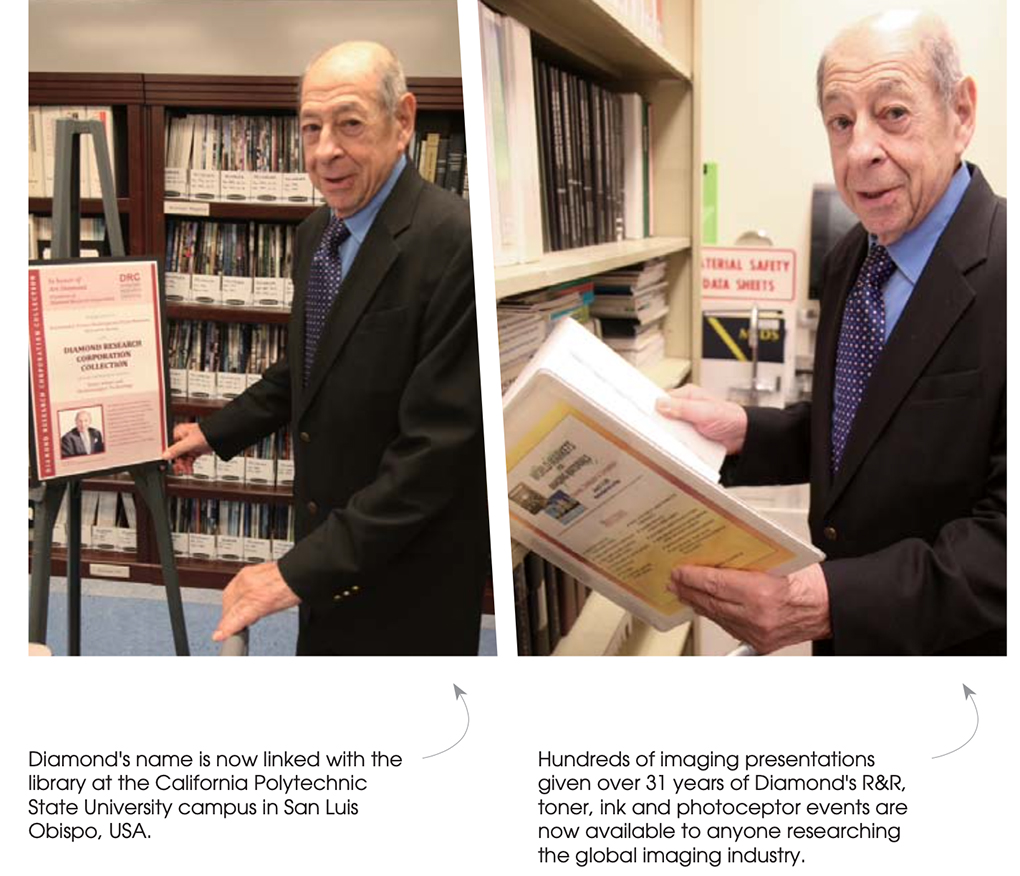 At the time Diamond was turning 85, I took the trip to Ojai in California, to catch up with the man who had been my mentor, and friend. He was recovering from yet another hip surgery.
At the time Diamond was turning 85, I took the trip to Ojai in California, to catch up with the man who had been my mentor, and friend. He was recovering from yet another hip surgery.
But that was not going to stop him from getting a pass from the hospital to go, with me, to the California Polytechnic State University campus in San Luis Obispo.
The University had previously been quick to accept the donation of Diamond’s collection of imaging resources and library.
In order to provide a legacy for his lifework in imaging, Diamond’s name has been placed on the library wall and on an endowment fund that will see his passion for the industry continue with research, education and training in toner, inkjet, photoreceptor and related imaging technologies.
But do you know the story?
Fascinated with Imaging Technologies Since Age 8
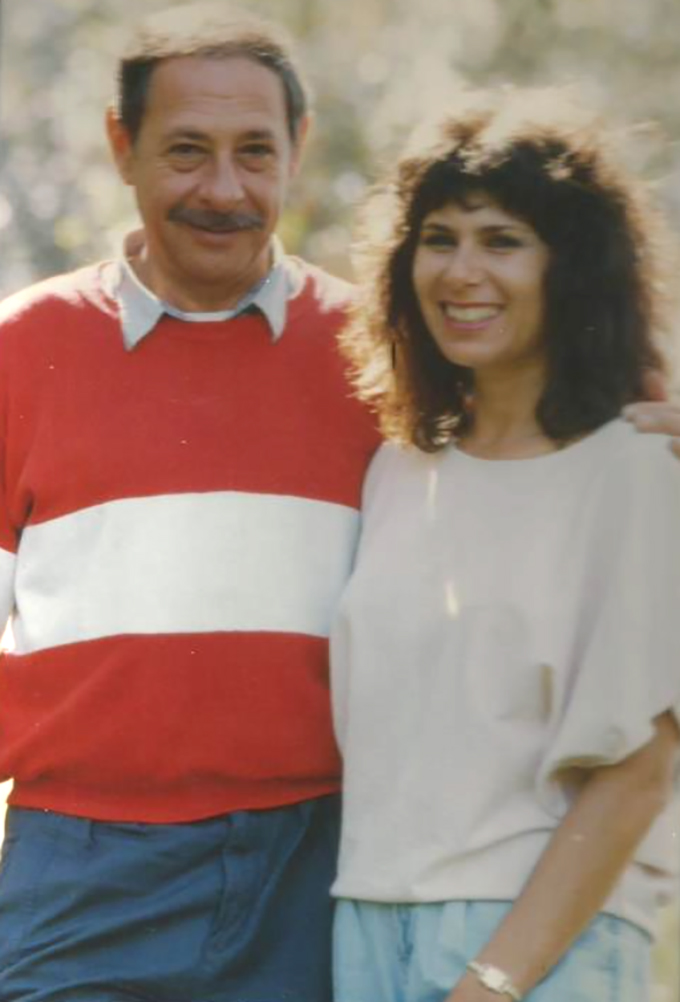
Diamond and daughter Eve
The youngest of three children, Diamond was born on September 2, 1930, in Canarsie, a seaside suburb of Brooklyn, New York. He spent most of his free time in the local library where he developed an early interest in photography.
By the age of 8, he had established a full darkroom in the basement of the family home and became proficient in the development of film, and the printing and enlarging of black and white photographs. He excelled at school and was a class leader in math, science and English and graduated from both grade and high school in accelerated time.
From the age of 13, he spent his summers riding the New York subway, and hitchhiking to find work as a handyman or waiter. “In those days it was totally safe thumbing a ride, alone on the highway—there was no threat of kidnappers, child molesters and serial killers,” Diamond adds.
From those summer earnings, he accumulated savings, for two long-desired acquisitions: a 4×5-inch Speed Graphic press camera and an automobile.
He bought the camera on his 16th birthday, and a blue, 1932 Ford convertible coupe, with ragtop and rumble seat on his 17th birthday.
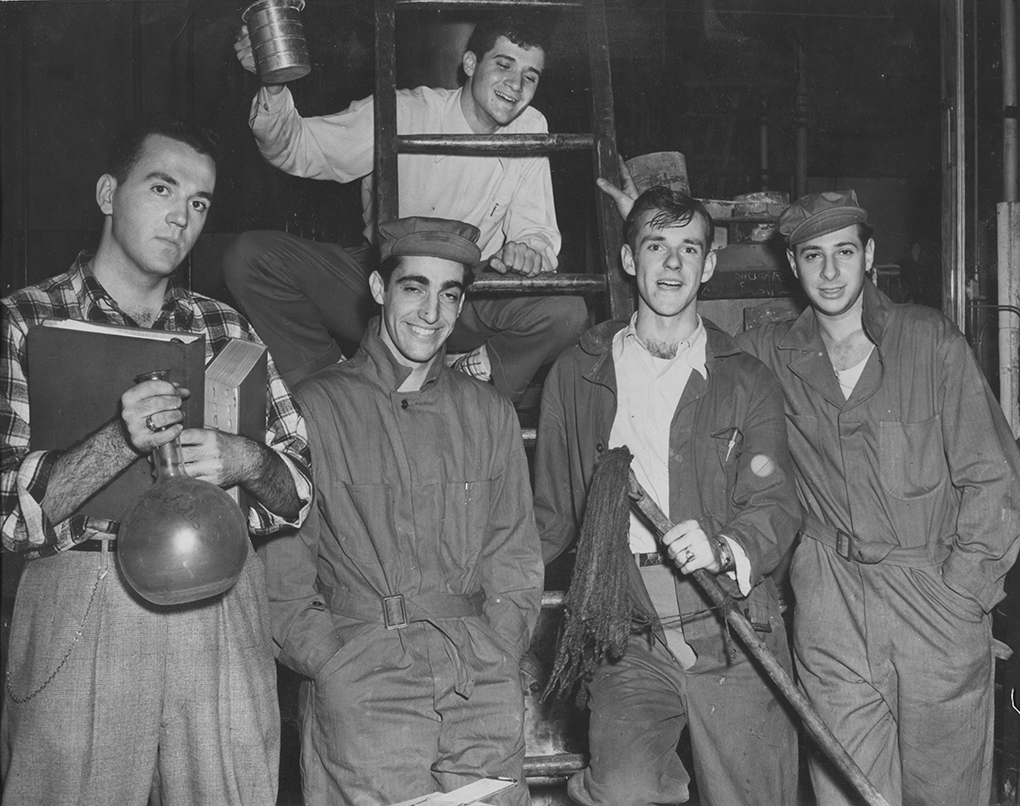
Chemical engineering Team at Brooklyn Polytechnic (ca. 1951): (L.to R.) Thomas Cartolano, Archie Torrenzano, Richard Limoli, Marshall Snyder, Art Diamond
He pursued his deep passion for photography as a freelance cameraman, shooting weddings, anniversaries and sports events while studying commercial, news and portrait photography at the Metropolitan Vocational High School on the lower East Side of Manhattan. His deep fascination with the chemistry of photography led him to choose chemical engineering at the Polytechnic Institute of New York in February 1948.
There, he served as Photo Editor of the school newspaper, The Polytechnic Reporter. Upon graduation in 1951, he was awarded a Bachelor of Science degree in Chemical Engineering (BSChE) and spent the next two years as an engineer with the refinery design firm, M.W. Kellogg Company, now a division of Haliburton.
His Brilliant Career
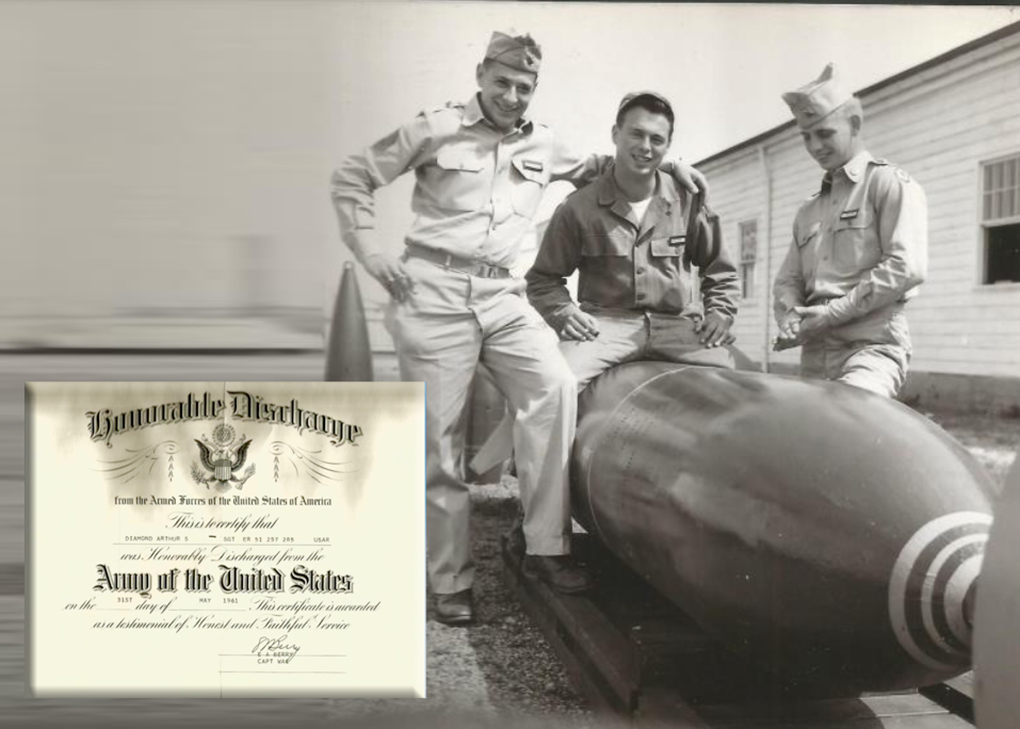
Diamond joined the United States Army in 1953 and received an honorable discharge in 1955. He served at the Aberdeen Proving Grounds in Aberdeen, Maryland.
In June 1953 he was drafted into the US Army and was headed for the iniquitous Korean War. Just one day before his departure, he was re-assigned to Aberdeen Proving Ground (APG) in Maryland as an Instructor in small arms ammunition, missiles and rockets.
Having been designated as a member of the Scientific and Professional Personnel (SPP) group of servicemen, he rose from private, to corporal, to the rank of sergeant, and was named Head of the group of SPP soldiers stationed there before being Honorably Discharged in June 1955.
During that time he invited recruiters from major American companies to visit APG, and interview soldiers with scientific and engineering degrees who were approaching discharge. In this capacity, he met a representative of Eastman Kodak Company who eventually offered him a position at Kodak Park.
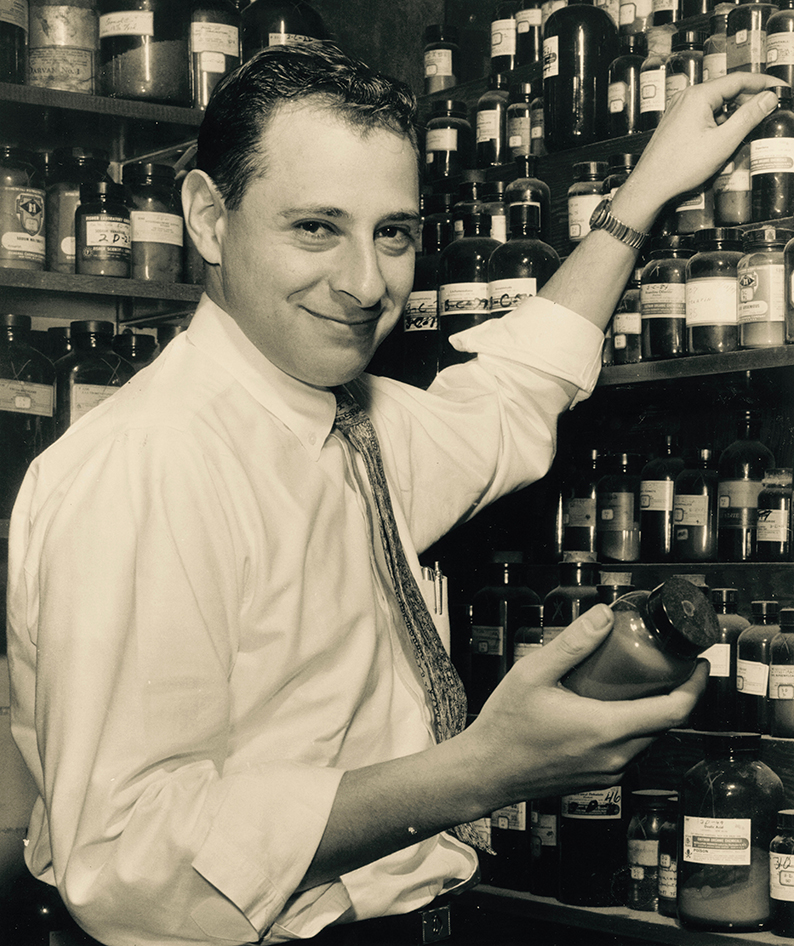
Diamond at Kodak Research Laboratories (ca. 1958)
While carrying out his duties as a Research Scientist at Kodak’s Research Laboratories, Diamond saw the need for quantifying the bond between gelatin film emulsions and their paper or film substrate. “At that time, film coating machine operators were using a primitive ‘fingernail test’ to evaluate adhesive bonding and abrasion resistance. I developed a rigorous procedure for defining a coefficient of adherence that became a standard test method at Kodak for evaluating various coatings.” This novel procedure became his thesis at the University of Rochester which earned him an MSChE.
Even though Kodak offered Diamond a major promotion with a long-term commitment, Diamond opted to relocate, taking a job with Times Facsimile (a division of Litton Industries) in Manhattan.
His experience with photosensitive zinc oxide brought him to the attention of the Charles Bruning Company in Mt. Prospect, Illinois. Bruning chemists were working on a water-based zinc oxide coating as the image forming paper substrate to use in an electrophotographic process named Electrofax developed by RCA chemists. This process became widely known as the coated paper version of Xerox’s plain paper xerography.
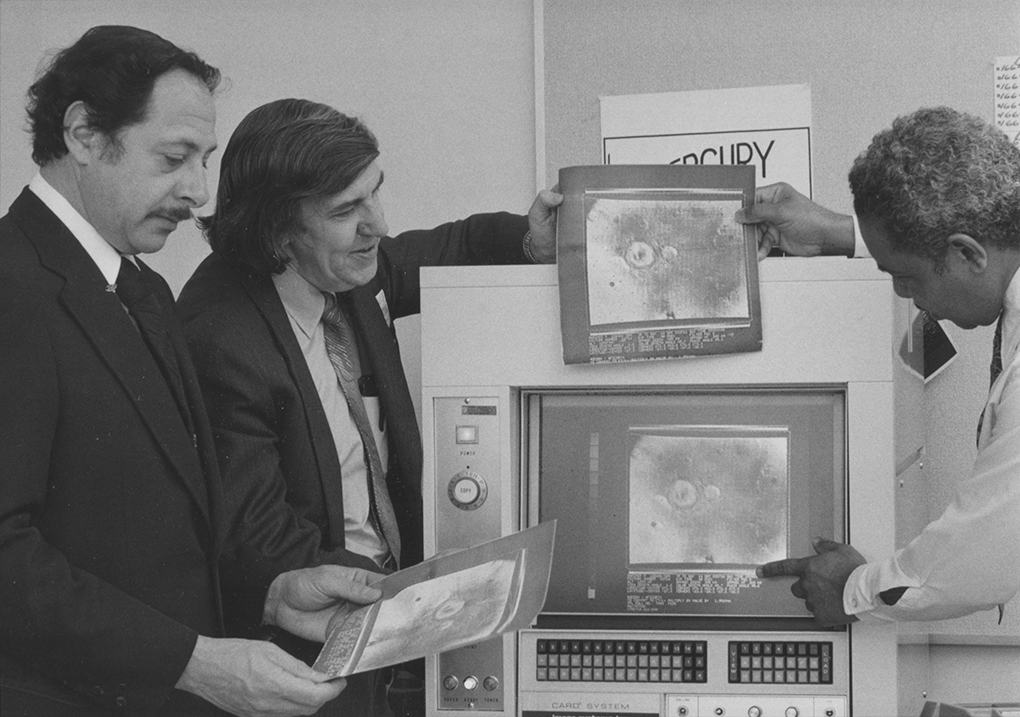
Diamond demonstrating Electrofax process at Jet Propulsion Labs (ca. 1995)
At Bruning, he demonstrated that water-based zinc oxide coatings were too moisture-sensitive to deliver reliable performance over the full range of normal office ambient humidity. Together with the scientists there, they reformulated to a solvent-based coating and within a few years annual sales of Bruning’s Copytron papers and offset printing masters had zoomed to $30 million.
This was followed by a move to the west coast of the USA in 1967, to follow an attractive offer from Telautograph in Los Angeles, as Chief Chemist at this facsimile based company—involved with the instant transmission of black and white photographs from cameraman to publisher for the news media. Together with David Carr, Diamond reformulated the image forming solution used to impregnate electrolytic recording papers to a more acceptable, non-catechol composition (see US patents 3,668,079 and 3,687,822).
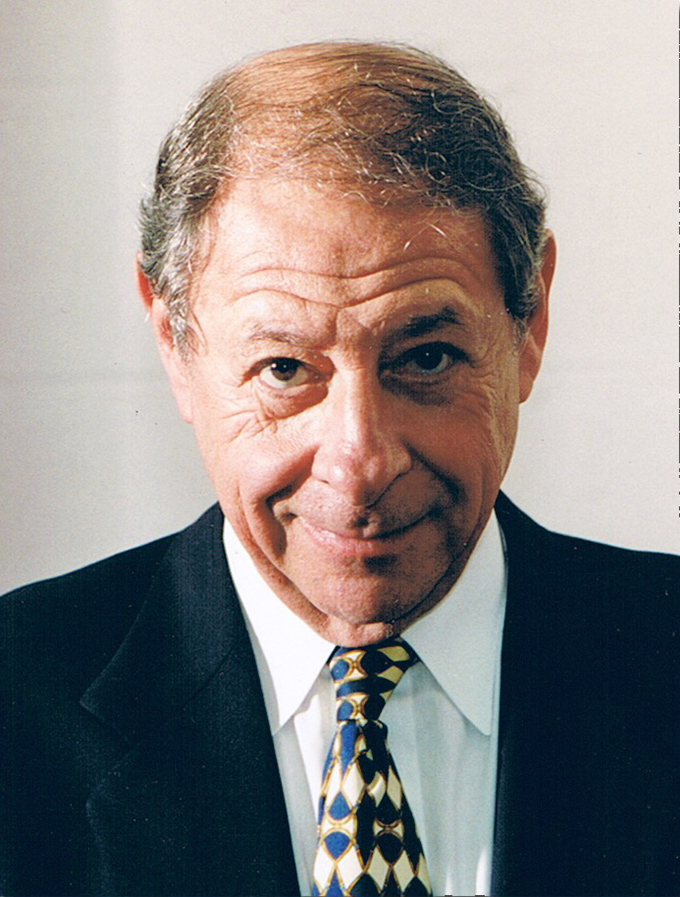
Art Diamond Portrait (circa 2005)
Boldly, Diamond set up his own consultancy business in 1968. Diamond Research Corporation (DRC) engaged Telautograph as its first client but rapidly grew with assignments from the corporations of the like of Ricoh and Singer, among others. During the mid- 1990s, he was also named President of the Consulting Chemists Association in Los Angeles, a position he held for 5 years.
One client, a toner manufacturer in Turkey, retained DRC to assist in their formulation and production of dry toners. After touring the facility and making a number of key recommendations regarding production operations, Diamond was able to substantially reduce the unit manufacturing cost of their line of toners for copiers and printers.
Diamond smiles. The memories are all good ones. He recounts the time when he saved the jobs of about 900 employees at the Mead Paper Company (now, Mead/ Westvaco) after solving a mysterious problem with an R&D team he formed from among their chemists and engineers.
Back to the Future
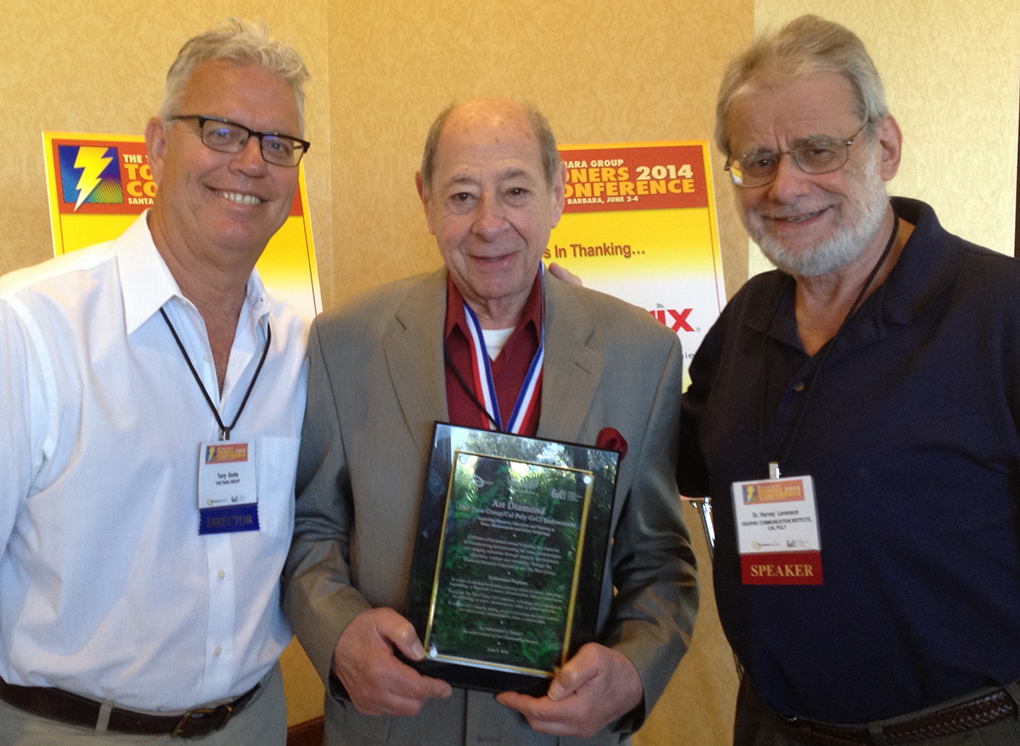
Friends and colleagues Terry Gorka, Diamond and Prof Harvey Levenson
In 2012, DRC and polymer chemist, Velliyur Sankaran, entered into an agreement with Eastman Kodak Company to develop monochrome and color toners having a high content of bio-derived raw materials, primarily resin. Under previous consulting assignments, DRC had gained experience with toner-based resins derived from field corn (inedible).
After almost two years of R&D, Diamond and Sankaran, working with Kodak and a bioresin supplier, were successful in producing a biotoner having close to 100% bioresin, as determined by radioactive carbon measurements. Kodak will shortly announce the availability of its proprietary, ultra-high biocontent, color, chemical biotoner.
Diamond glances out the window, and reflects on all he has shared with me. “Do you think I have made a difference?” he asks. “Is the imaging industry a better place because of my achievements?”
I didn’t need to say a word. Kodak’s Dan Burmeister came knocking at the door to glean more industry intelligence from Diamond. ■
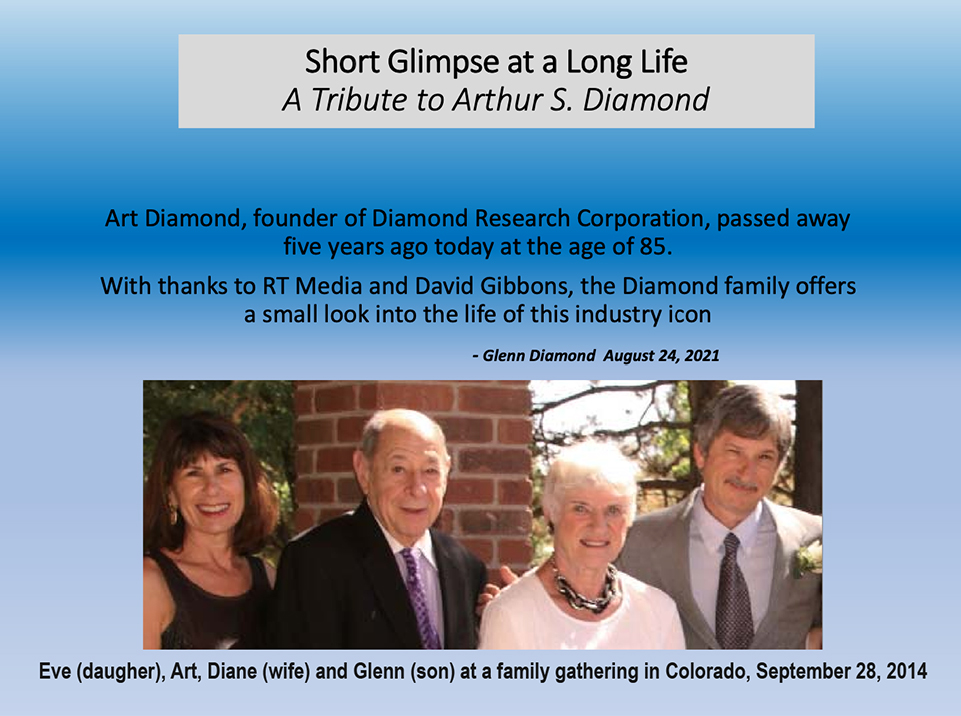 RT would like to thanks Art Diamond’s family, particularly his son Glenn and daughter Eve, for supplying images of their father in this feature as well as as a “Short Glimpse at a Long Life.”
RT would like to thanks Art Diamond’s family, particularly his son Glenn and daughter Eve, for supplying images of their father in this feature as well as as a “Short Glimpse at a Long Life.”
Related:
- Fascinated with Imaging Technologies Since Age 8
- Industry Pioneers Declared to be Diamonds
- August 24, 2016: Art Diamond Passes
- Industry People Pay Tribute to Art Diamond
- Watch: JUST A MINUTE – Art Diamond
- Diamond Family Respond
Please add your comments below about this feature, “Fascinated with Imaging Technologies Since Age 8” or join the conversation on LinkedIn.


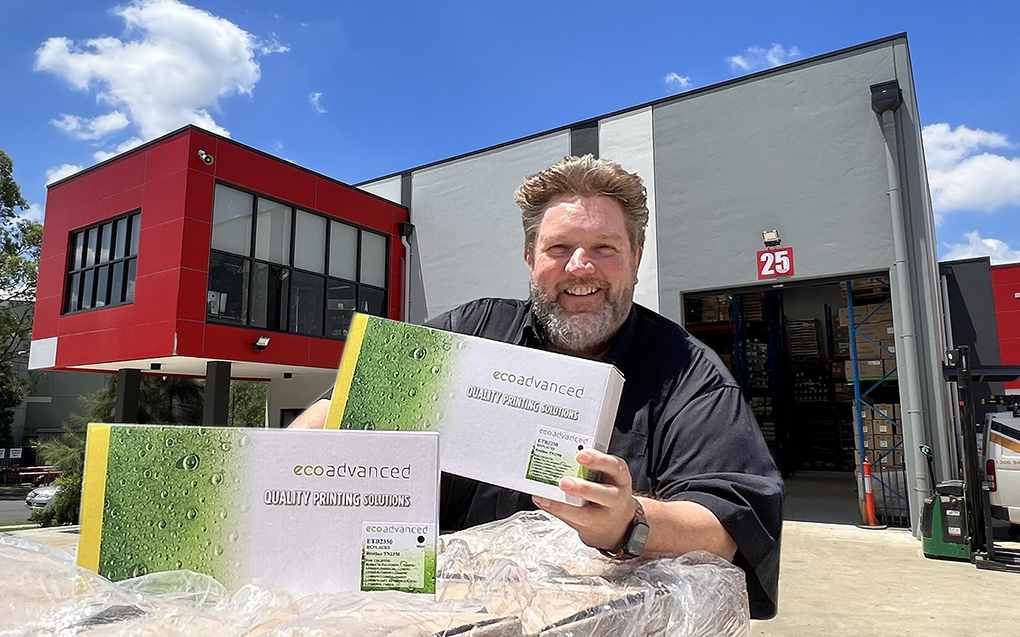

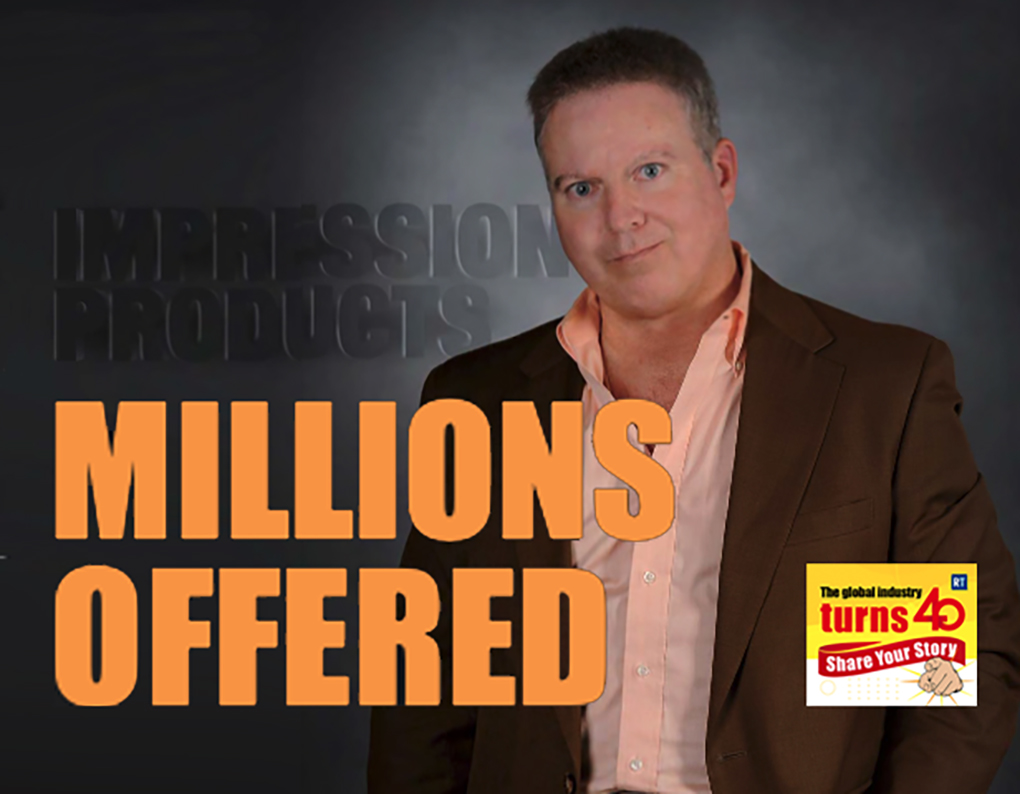
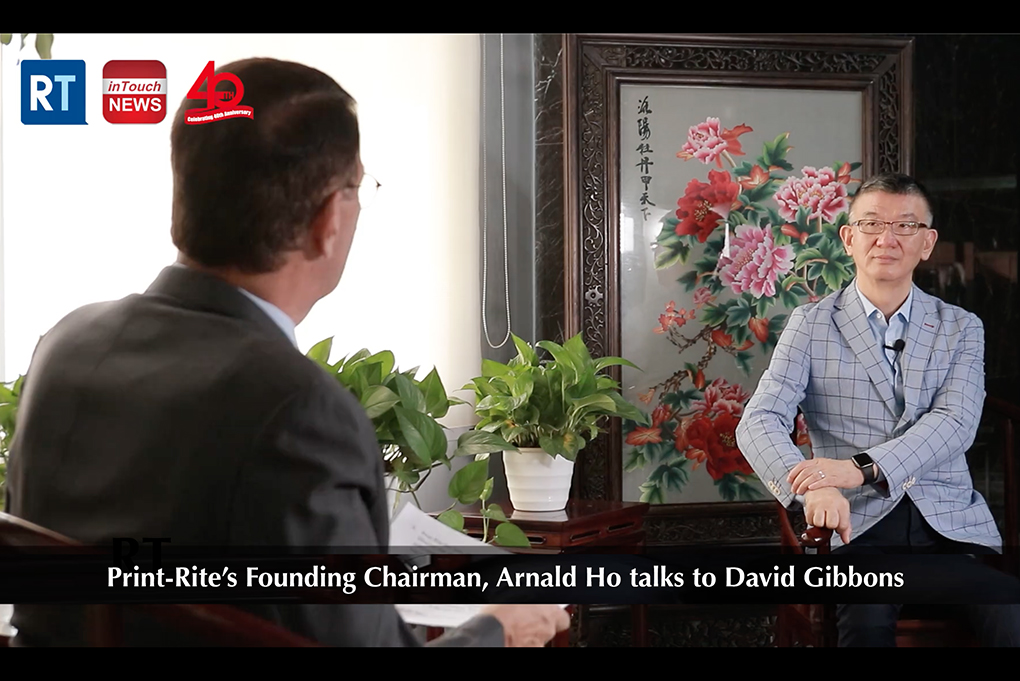
There is so much more where Art left a lasting memory as today there are industries that know quite well how a simple little comment altered the entire research work and save us from going nowhere and end up broke.